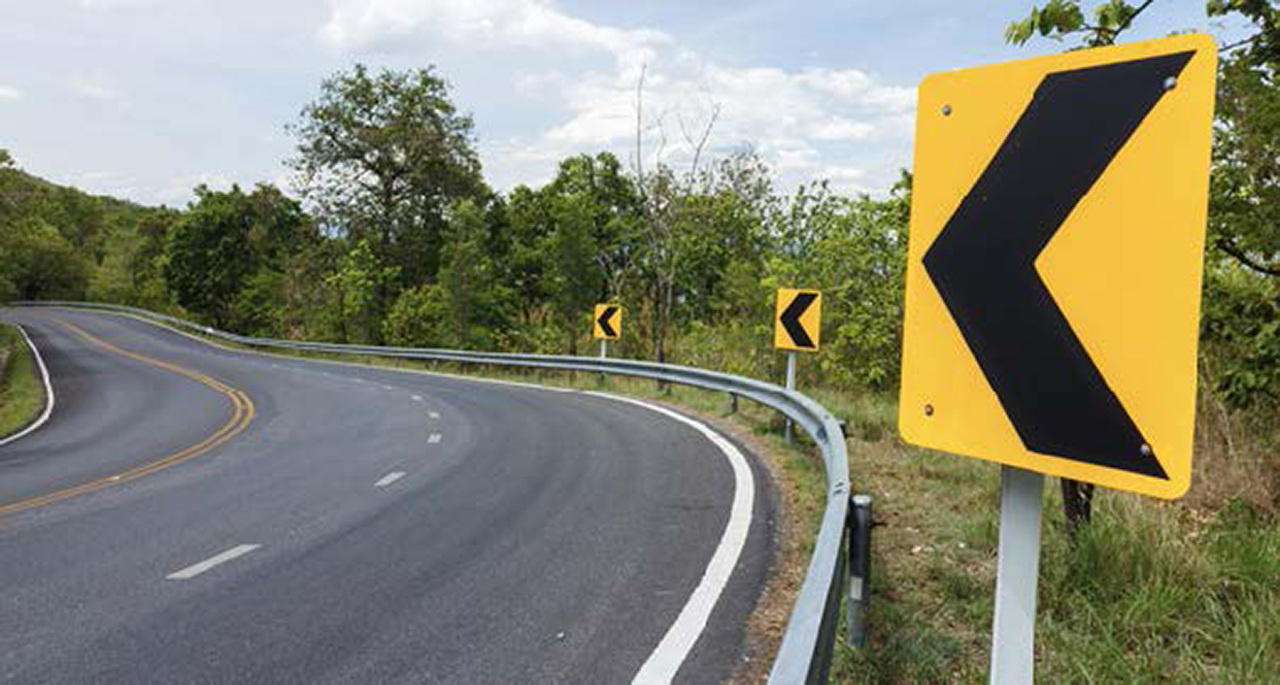
Photo credit: Sittichai © 123RF.com
State and federal entities acknowledge that some local agencies have limited staff and their responsibilities cover a broad range of work that often monopolizes their time. They frequently are unable to take the necessary training to understand or apply traffic safety methods. In response, agencies have developed tools to help guide local practitioners through the HSIP safety analysis process. Federal and state agencies have developed the following resources to provide local agencies with safety analysis training and tools:
The Improving Safety on Rural Local and Tribal Roads – Safety Toolkit (FHWA, 2014a) helps rural, local, and tribal roadway safety practitioners address safety challenges and integrate road safety into their existing responsibilities.
The Toolkit provides a seven-step process to complete traffic safety analyses, identify safety issues, identify countermeasures to address the issues, and develop an implementation process. Each step contains a set of tools, examples, and links to appropriate resources to meet the needs of safety practitioners (Figure 5-1):
Figure 5-1. FHWA Safety Analysis Process
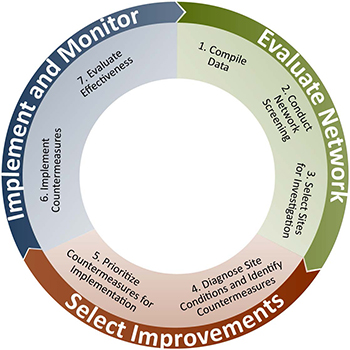
The Safety Toolkit, in addition to other FHWA training, tools, guidance, and countermeasures for local practitioners, is online at: https://highways.dot.gov/safety (FHWA, 2017).
The Traffic Safety Fundamentals Handbook (MnDOT, 2015) focuses on providing the information most often requested by local agencies. MnDOT published the original version in 2001, with updates in 2008 and 2015.
More than 3,500 copies have been distributed through MnDOT’s outreach to government agencies and the private sector. In addition, the Handbook is used as a resource in undergraduate and graduate traffic engineering classes at the University of Minnesota and is available to professionals in other states online at: https://www.dot.state.mn.us/trafficeng/publ/fundamentals/2015-mndot-safety-handbook-reduced.pdf.
The Handbook is organized into three sections:
Agency staff refer to this Handbook for guidance on safety context, analysis, comparisons, and countermeasures.
The New Jersey DOT (NJDOT) requires HSIP applications to be based on the state’s HSIP Manual (NJTPA, 2016). To help local agencies comply with this requirement, the NJTPA sponsored four, free 2-day workshops on Highway Safety Manual (HSM) analytical techniques, key assumptions, and benefit/cost ratio computations. FHWA’s Resource Center, FHWA’s New Jersey Division Office, NJDOT’s Bureau of Transportation Data and Safety, and NJTPA provided the instructors. The target audience included metropolitan planning organizations and local agency engineers. The workshop included 1-hour time slots for local agencies considering submitting a project for HSIP funding to present details about their projects. Instructors provided feedback to local agency engineers about HSM assumptions and the suggested approach for analytical techniques.
To date, almost two-thirds of NJTPA’s 15 sub-regions have participated and applications for 26 safety projects have been adopted by the NJTPA Board of Trustees for funding through the Local Safety Program (NJTPA, 2016).
These three noteworthy resources provide local agencies with safety analysis training and tools. To ensure staff receive this training, local agencies could:
Figure 6-1. Local/State Fatalities Trend Line
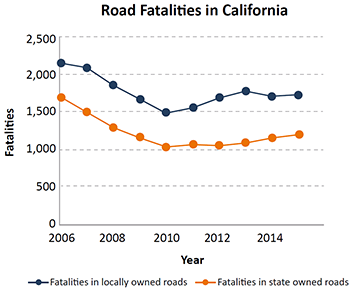
Source: Fatality Analysis Reporting System [FARS], 2017; Adapted by FHWA
In 2014, California formed a local HSIP Advisory Committee to increase local agency participation in California’s HSIP and to support the state’s goal to reduce traffic fatalities (Figure 6-1) and serious injuries on California public roads. The Advisory Committee provides California’s local HSIP and other safety programs with safety guidance on California’s local roadways. Committee members include the California Department of Transportation (Caltrans) - Division of Local Assistance, U.S. Federal Highway Administration (FHWA), the Local Technical Assistance Program, and local agencies throughout California.
The Advisory Committee’s Charter (Appendix C, Desired Goals, Advisory Committee Charter, 2017) identifies six goals:
The Advisory Committee is co-chaired by Caltrans and a representative from a local agency, and includes 11 members representing cities, counties, and regional/metropolitan planning agencies. The goal is for committee members to represent urban and rural areas distributed geographically across the state.
The Advisory Committee (Appendix C) adopted four key initiatives:
Since 2014, the outreach, training, and technical assistance provided by the Advisory Committee increased local agency participation by almost 40%. This translates to a 70% increase in the level of safety funds dedicated to local system projects (from about $65 million programmed for Fiscal Years 2012 and 2013 to $100 million in 2015 and $140 million in 2019) (Kochevar, 2017, pers. comm) (Figure 6-2).
Figure 6-2. HSIP Funding for Local Road Safety in California
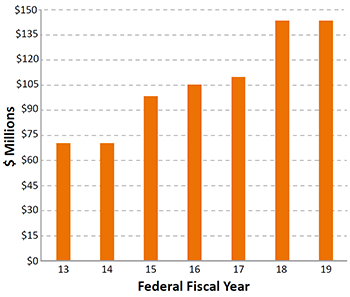
Source: Kochevar, 2017, pers.comm.; Adapted by FHWA
Figure 6-3. Injury Severity Quantified in California
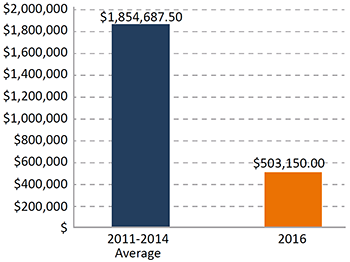
Source: Mattox, 2016, pers. comm.
Figure 6-4. Rural Highway Shoulder Paving in California
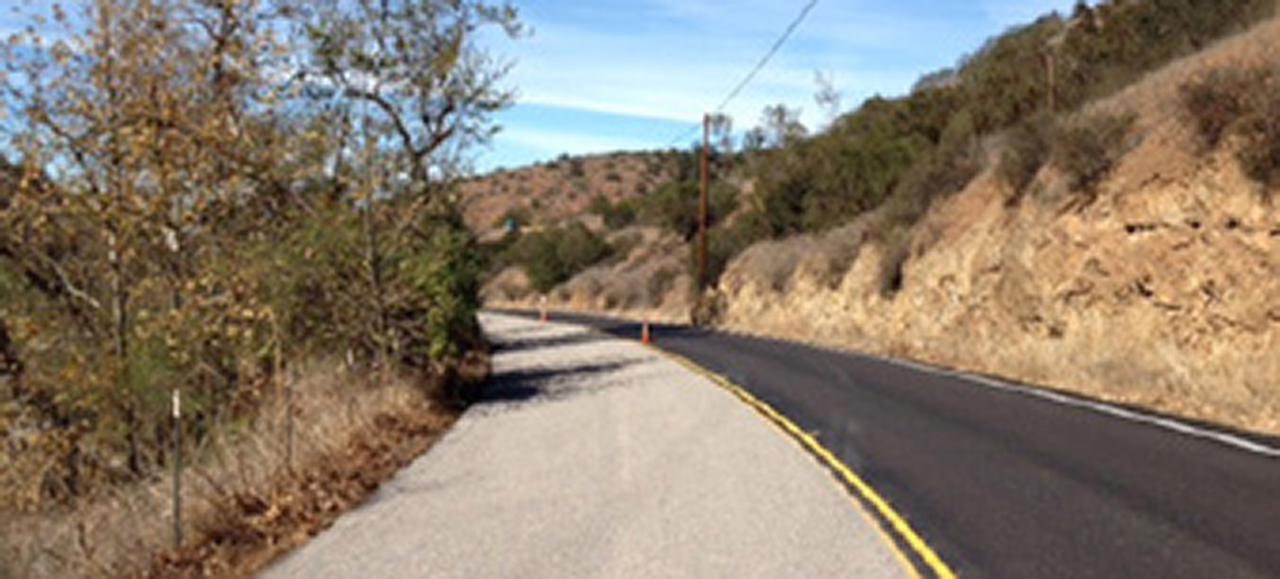
Source: Kochevar, 2017, pers. comm.
Figure 6-6. Illustration of Multiple-threat Pedestrian Crash
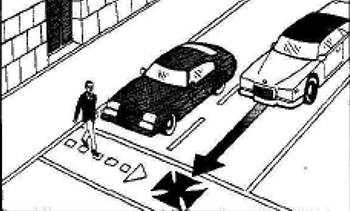
Source: FHWA, 2005
The Town of Paradise has benefited from state efforts to increase the number of cities and counties participating in the HSIP. Prior to securing HSIP funds, Paradise’s $1 million annual capital budget focused on expanding the roadway system to accommodate growth and managing 100 miles of roads. In the past 3 years, Paradise has supplemented its capital budget with $8 million in HSIP funds, which has supported adding a shoulder paving/bike lane project, adding a two-way left-turn lane to Clark Road, upgrading the town’s signal system by adding pedestrian countdown timers and emergency vehicle pre-emption, and implementing a road diet along Skyway Road (Mattox, 2016, pers. comm). A project along Skyway Road (Figure 6-5 and Figure 6-7) converted the four-lane undivided cross-section to a three-lane cross-section and improved signal coordination. It also added pedestrian enhancements, including crosswalks, curb extensions, refuge islands, and activated flashing beacons. Prior to these enhancements the crash rate on Skyway Road was more than twice the statewide average for similar facilities. Pedestrian crashes were the key component, especially multi-vehicle threat crashes common to four-lane roads (Figure 6-6).
According to U.S. Federal Highway Administration (FHWA), “A multiple-threat crash involves a driver stopping in one lane of a multilane road to permit pedestrians to cross, and an oncoming vehicle (in the same direction) strikes the pedestrian who is crossing in front of the stopped vehicle. This crash type involves both the pedestrian and driver failing to see each other in time to avoid the collision” (FHWA, 2005). After completing the HSIP-funded safety improvements project, the Town of Paradise reported the following successes (Mattox, 2016, pers. comm):
Figure 6-5. Downtown Paradise Road Configuration Change Before

Source: Mattox, 2016, pers. comm.
Figure 6-7. Downtown Paradise Road Configuration Change After

Source: Mattox, 2016, pers. comm.
The California Advisory Committee has successfully increased local participation in California’s HSIP by developing a local HSIP Advisory Committee. To develop a similar committee, a local agency could:
In 2012, Thurston County in Washington State conducted a data-driven safety analysis to identify and prioritize potential safety projects that would be eligible for Highway Safety Improvement Program (HSIP) funds.
In late 2013, Thurston County determined that wet/icy pavement contributed to 47% of crashes and identified high friction surface treatment (HFST)—a new and innovative technology proven effective at reducing crashes, particularly on wet pavements—as a solution. However, Thurston County had no prior experience with HFST and neither the Washington State Local Technical Assistance Program (LTAP) nor the U.S. Federal Highway Administration (FHWA) could answer Thurston County’s questions about local implementation (installation costs, materials, and ongoing maintenance issues). To resolve the unanswered HFST inquiries, Thurston County worked with LTAP and FHWA to coordinate a peer exchange and pilot project.
Using information received from other agencies with experience in implementing HFST Thurston County partnered with Washington State LTAP and FHWA to secure funding to cover materials and installation at two demonstration sites, selected to compare different installation methods. To share the lessons learned on HFST, the partnering agencies hosted a peer exchange, featuring an installation demonstration, and attended by 37 representatives of various local agencies, the Washington State DOT (WSDOT), FHWA, and the Western Federal Lands Division. The demonstration included an application of HFST applied by Thurston County traffic and road maintenance crews and was followed by a detailed overview of HFST by national experts.
Since the peer exchange and pilot projects, there have been at least 36 planned or installed HFST sites in the State of Washington (state and local roads). In addition, eight counties, including Thurston County, submitted HSIP funding applications to WSDOT for HFST sites in the summer of 2016. In December 2016, WSDOT awarded Thurston County more than $2 million for HFST at 29 locations.
Thurston County has successfully partnered with Washington State LTAP and FHWA to implement a new and innovative, proven safety technology on local roads. To begin using a new technology on local roads, an agency could:
The Florida Department of Transportation (FDOT) District 7 (Tampa Bay region) has developed the Local Agency Safety Program to assist local agencies without the resources to identify, develop, and implement safety improvements on local roadways as part of their Highway Safety Improvement Program (HSIP) process.
The Local Agency Safety Program includes:
The Local Agency Safety Program provides resources to local agencies that result in improved understanding of traffic safety, project development, and the application process for project funding. In fact, “As a result of the improved level of understanding regarding the application process, the number of project submissions made by local agencies increased from averaging 3 applications each year to 50+ applications” (U.S. Federal Highway Administration (FHWA), 2013).
FDOT District 7 hosts an annual seminar called the Local Agency Traffic Safety Summit. This seminar is geared toward local agency staff, elected officials, and independent industry consultants. The purpose of the seminar is to (FHWA, 2013):
FDOT District 7 hosts an annual seminar called the Local Agency Traffic Safety Summit. This seminar is geared toward local agency staff, elected officials, and independent industry consultants. The purpose of the seminar is to (FHWA,2013):
The LATSA is a webinar-based program that trains participants in best practices for successful implementation of safety projects. LATSA focuses on topics relevant to local agencies in District 7 including:
The webinars are free and presenters are experts in a variety of fields including consulting, government, and education and research.
LATSA began in 2013 and is online at (FDOT 2017a):
http://tampabaytrafficsafety.com/education/latsa/.
The LATSA is a webinar-based program that trains participants in best practices for successful implementation of safety projects. LATSA focuses on topics relevant to local agencies in District 7 including:
FDOT District 7 provides guidance for local agencies submitting project funding requests. Since submitted projects are closely reviewed by FDOT, this guidance prompts local agencies to consider what FDOT will be looking for during its review. For instance:
Figure 8-1. Improved Overhead Signage in District 7:
Before (top) and After
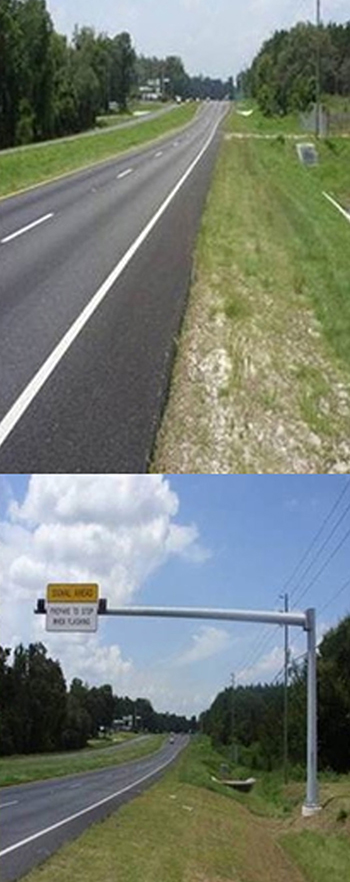
Source: Florida Department of Transportation
FDOT District 7 supports local agencies during project implementation through:
DBPB projects are expedited and do not require the standard FDOT review. In fact, each task is completed in less than 1 year. According to FDOT, “The push button framework allowed the District to reduce the time it takes to deliver simple or low-cost safety improvement from 3-5 years to 3-9 months (FDOT, 2017b).” According to FDOT, the DBPB has accomplished the following:
Through its Local Agency Safety Program FDOT District 7 has successfully provided resources to help local agencies identify and develop traffic safety solutions as part of the HSIP process. To develop a similar program, an agency could:
RSPCB Program Point of Contact
Felix Delgado, FHWA Office of Safety
Felix.Delgado@dot.gov
FHWA Office of Safety
Staff and Primary Work Responsibilities
FHWA Office of Safety
Safety and Design Team
FHWA Resource Center